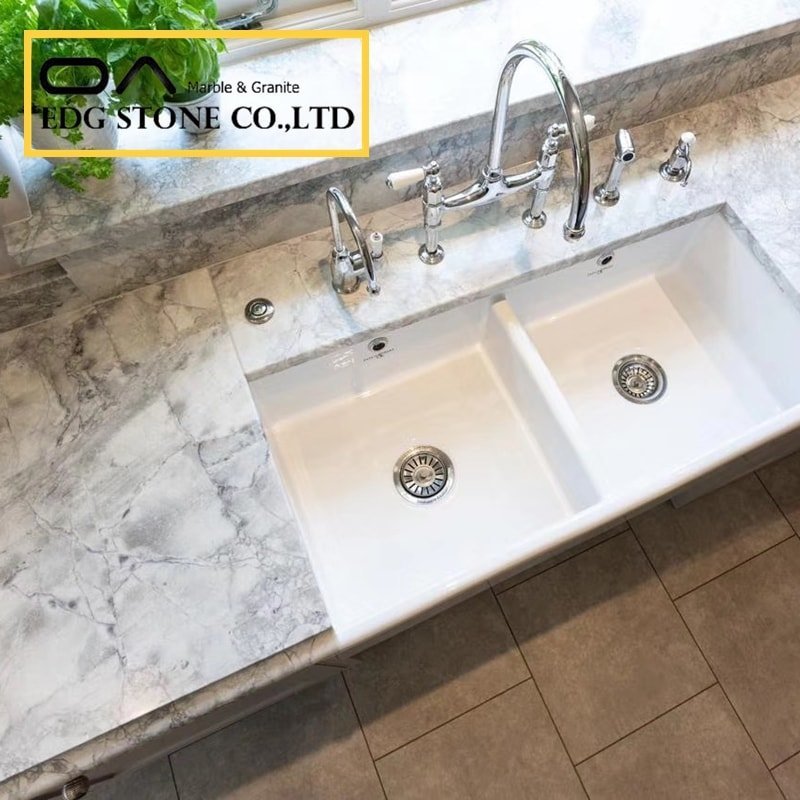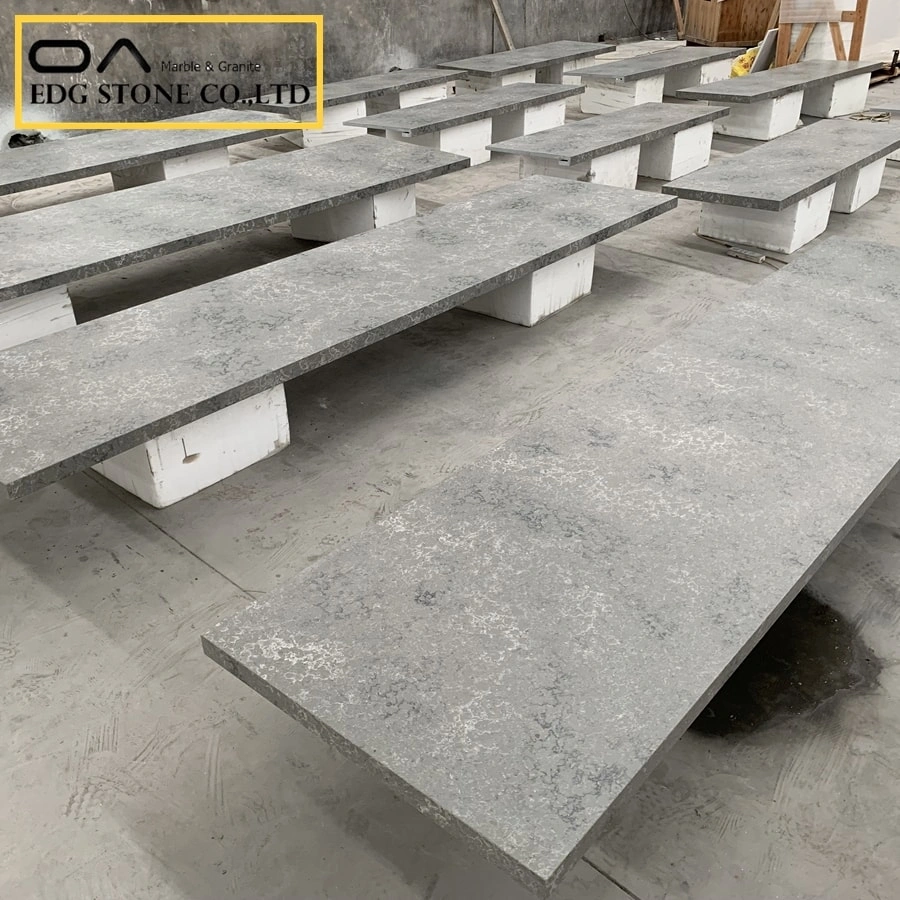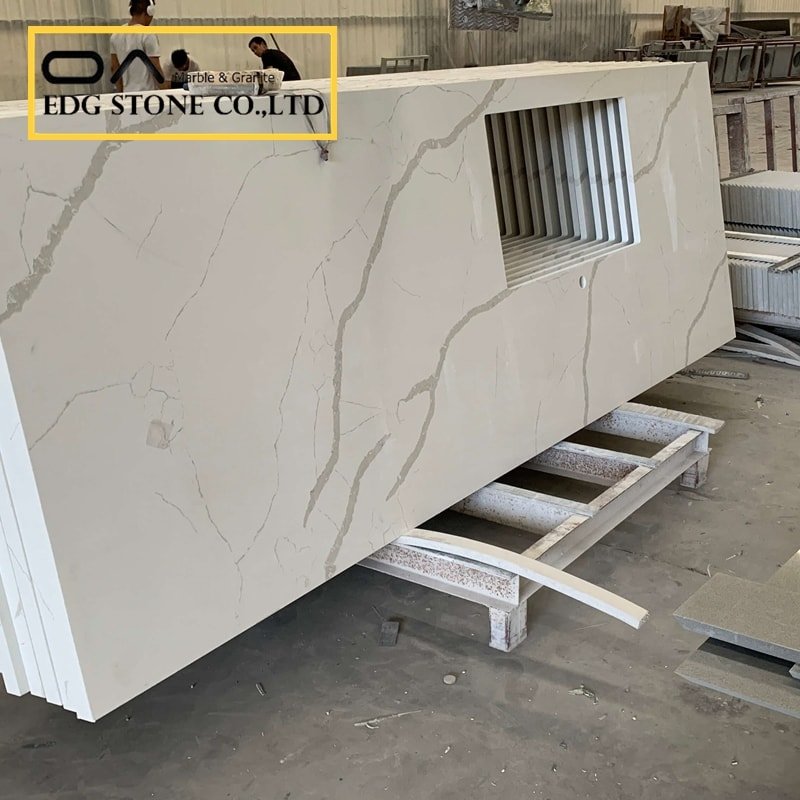The design of the product should pay attention to science and design on the premise of mechanical theory. However, the product design of stone is not necessarily reasonable because of the lack of theoretical knowledge of mechanics by the designer himself. We often see that the design of stone countertops is long and large, and there are also long and narrow designs, which is incorrect from the theory of mechanics. The design of the countertop should be considered from the strength and deflection of the stone to be correct and reasonable.
1. Mechanical theoretical basis of bench panel design
σ=(3F*L)/(2b*h*h)
F—Breaking load (i.e. bearing force); L — span; b—width; h—thickness.
From the above formula, we know that when the length of the table panel is longer, the σ is larger with the same cross-sectional area. When the σ is larger, the countertop is easier to bend. When the σ is greater than the bending strength of the stone itself, the countertop will break. The deflection under a single load is calculated as f=-FL3/(48EI), and the formula I = bh3/12, E is the elastic modulus of the stone.
The formula above shows that when the L of the table panel is longer, the easier it is to bend the table panel of the same section. When the deflection is larger than the allowable deflection limit of the stone itself, the countertop will break.
The above two formulas are the mechanical theoretical basis for designers to design the length of the bench panel.
2. Status quo of countertop products
First, look at some countertop products.
Figure 1 shows a cantilevered countertop. There is only one fulcrum in the middle that supports it. When the length of a tabletop like this is long, the ends will be deformed by the weight of the tabletop itself. If the thickness of the countertop is thin, less than 16mm, such a long countertop must be deformed downward at both ends of the action point with the middle fulcrum as the force.
The Nakajimadai of Hanjiangxue in Figure 2 is processed by the author. Because the thickness of the stone is 16mmm, it can be seen from Figure 2 that the countertop is deformed.
Figure 3 is also the bathtub countertop in a high-end residential real estate project in Shenzhen that the author has experienced. The bathtub countertop is 2500 long and 1250mm wide, with a hole in the middle of the bathtub. Due to the long length of this countertop, the digging holes, coupled with the cracks of the stone, frequent fractures during the processing process and construction, and finally 50*3mm aluminum alloy plates along the perimeter of the bathtub countertop to complete the processing of the product.
Figure 4 shows a round countertop with a diameter of 3 meters and processed from white jade. The panel is machined in four pieces, and the string length of each piece is up to 2 meters. In the factory trial assembly, because of the large diameter, long chord length, and serious deformation of the countertop, the trial work was barely completed by using metal sheets and wooden wedge pads.
The kitchen counter panel is an indispensable product for home decoration, but the countertop with a large difference in aspect ratio and a sinkhole is easy to deform.
Figure 6: This Nakajima is also processed by the author. Although the horizontal and vertical of the island platform panel in Figure 6 are reasonable because a long hole is dug at the front end of the island platform, an “L” shaped mouth is formed, resulting in the panel being easy to break. Later, the bottom of the countertop was reinforced with a 100*3mm aluminum plate to complete the processing of the product.
Figure 7 This kitchen counter panel processed with stone slabs has two more holes dug, and if the thickness of the stone slab is 12mm, this kitchen counter panel will be deformed.
The thickness of the countertop in Figure 8 ~ Figure 10 is so thin, especially Figure 10, this kind of countertop is too long after a period of use, and the support structure of the countertop is unreasonable, it must be deformed.
3. Some technical measures to prevent the deformation of the countertop
(1) Increase the thickness of the countertop
Figure 11: This slender, small aspect ratio of the countertop must be thickened. Figure 11 is indeed thickened, and the thickness of the stone should not be less than 50mm from the picture.
Therefore, when the length of the countertop is greater than 2000mm and the aspect ratio is less than 0.6, the author believes that the thickness of the stone should be thickened by 5mm~10mm.
(2) Reinforce the bottom of the countertop
Figure 12 When the diameter of this suspended table panel is only supported by a fulcrum, it is easy to deform if it is processed with stone below 20mm thickness. In order to prevent the deformation of the countertop, the countertop can be reinforced by way to increase its bending strength and reduce the amount of deformation.
Figure 13 is so long, that the countertop with a small aspect ratio is reinforced with stone bars in the length direction and three metal bars in the width direction behind the countertop. This means of such reinforcement ensures that this stone countertop will not be deformed.
(3) Increase the number of supports
For the table with long length and small aspect ratio, the support point can be increased along the length direction to increase the strength of the table and reduce the deformation of the table panel.
(4) Reduce the number of digging holes
If the number of openings is too long, because of the concentration of stress, the table panel is easy to break under high stress at the corner of the hole. Figure 16 This kind of table panel with 6 holes is obviously unreasonable, and the strength of the table panel is greatly affected and easy to deform. Fracture; The countertop in Figure 7 is thickened because of the holes dug; The countertop in Figure 18 has dug two basin holes, so the countertop is thickened in the form of bonded edges, which has a great effect on increasing the strength of the countertop and reducing deformation.
(5) Adjust the aspect ratio of the countertop
The aspect ratio of the countertop is an important design parameter. The author believes that the design of the countertop panel is better with an aspect ratio of not less than 0.6. For example, when the width of the countertop is 600mm, the length of the countertop should not be too much > 1000mm. Figure 19 The author believes that the horizontal and vertical comparison is appropriate, it is not easy to deform, and the bending strength of the stone is large.
Although the countertop of Figure 20 is long, the deformation of the countertop will not be too large because the horizontal and vertical are more suitable.
(6) Increase the number of segments and sub-pieces
Stone people know that when the length of the circular arc plate and the circular arc special-shaped plate is longer, that is, the fewer the number of spellings (parts), the longer the chord length of the circular arc plate and the circular arc special-shaped plate, the easier it is to deform. The reason why the large round table top in Figure 4 is deformed is that the chord length is too long, and the heavy weight causes the deformation of the tabletop. Therefore, when the diameter of the round table is too large when the aspect ratio is less than 0.6, increase the number of segments and reduce the chord length to ensure that the table has sufficient strength and small deformation.
(7) Reasonable design of support structure
Structural mechanics is an important physics discipline, not only applicable to engineering construction but also to the design of various products. The same goes for stone countertops. As long as the product structure and support structure of the stone countertop are reasonable, no matter how long the countertop can also ensure that the strength meets the requirements, the deflection is small (small deformation), and the product will not be deformed, and broken.
Comparing the two table panel structures of Figure 22 and Figure 23, the author believes that Figure 22 is more reasonable because the support is added in the middle to prevent the deformation of the force in the middle of the table panel.
The author believes that the two formulas at the beginning of the article are determined by calculation, and the calculation results meet the σ≤ [σ] and f≤ [f]. But these calculations are not calculated by non-mechanics professionals, and can only be designed empirically. When the length of the countertop is 2000mm and the width is below 600mm, when the aspect ratio is < 0.3, it should be regarded as an unsafe design scheme. The author has seen some artificial stone countertops of DuPont, whose width will not be less than 600mm, that is, its aspect ratio is >0.3, and DuPont naturally makes sense for this design.









